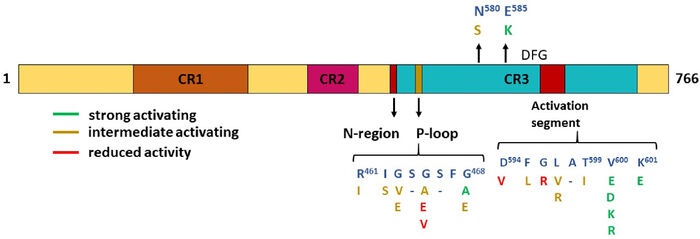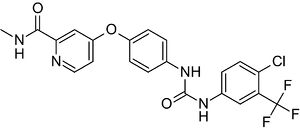User:Klára Kohoutová
From Proteopedia
Contents |
Structural basis of B-Raf oncogenic mutations
Introduction
B-Raf (Rappidly Accelerated Fibrosarcoma) is a 766-amino acid serine/threonine protein kinase with the ability to switch tyrosine kinase signalling to serine/threonine phosphorylation and connect growth factor receptors with transcription factors. B-Raf is considered to be the most important kinase in RAF-MEK-ERK signal transduction pathway which involves a cascade of protein kinases and is essential for cellular proliferation and differentiation of species ranging from worms to humans. [1] [2]
B-Raf kinase belongs to Raf kinase family which in vertebrates has three members – A-Raf, B-Raf and C-Raf. All Raf proteins share three highly conserved regions embedded in variable sequences. CR1 (conserved region 1) containing a RAS binding domain and Cys rich domain, [3] CR2 (conserved region 2) rich in Ser and Thr residues, some of which are regulatory sites[4] and CR3 (conserved region 3), a catalytic protein kinase domain. Raf kinase domain consists of N-lobe and C-lobe connected by a flexible hinge, the N-lobe is primarily responsible for ATP binding while the C-lobe is responsible for substrate binding. [5]
Catalytic function of B-Raf
B-Raf kinase acts to phosphorylate its downstream target MEK (Mitogen-activated protein kinase kinase) which in turn leads to phosphorylation of other kinases in the cascade. [6] B-Raf kinase domain switches between closed and opened conformation, however the active state is resctricted to the closed one. In B-Raf inactive conformation Phe594 of the DFG motif (Asp-Phe-Gly) at the N terminus of the activation loop blocks the ATP binding pocket. P loop(residues 464–471) forms hydrophobic interactions with the activation segment (residues 596–600) to stabilizes the inactive conformation. [7] A phosphorylation within the activation segment at residue Thr598 and Ser601 introduces negative charge which is unstable in the hydrophobic environment of the P-loop. [8] The change of conformation of DFG motif and activation segment opens the ATP binding pocket. [9]
Disease
Misregulation of cell-signalling pathways is often linked to cancer. In case of B-Raf over 30 mutations in its gene have been identified as oncogenic. A majority of these mutants are located within the kinase domain and enhance its kinase activity by maintaning the kinase domain in its active conformation. Increased B-Raf activity in turn leads to promoted tumor cell growth. [10]
Structural mechanism
Strongly activating mutations
Strongly activating mutations favour the active conformation without interfering with the catalytic process. These mutations mimic the conformational changes induced by activation segment phosphorylation. A Glu for Val substitution at position 599 accounts for 90 % of B-Raf oncogenic mutations. The aliphatic sidechain of Val599 interacts with the phenyl ring of Phe467 in the P-loop. Replacement of aliphatic Val sidechain with larger charged residue such as Glu, Asp, Lys, or Arg would destabilize the interaction that maintains DFG motif in the inactive conformation. In addition to that, it is also possible that acidic amino acid at the position 599 could interact with Lys506 of the αC helix and therefore further stabilize the active state. A Glu for Lys substitution at position 600 may also stabilize the active conformation by interacting with Lys506 and/or Lys569 of the αC and αE helices, respectively. [11]
Intermediate activating mutations
Intermediate activating mutations destabilize DFG inactive conformation but the overall catalytic activity is reduced compared to strongly activating mutations due to the fact that substitutive amino acids are in this case not optimal for catalysis. P-loop residue Gly468 contacts Leu596 in the inactive conformation therefore its substitution for Glu destabilizes the inactive conformation. However, it is known that in all protein kinases only Gly, Ala or Ser residues occur at this position. Bulky sidechain of Glu interferes with P-loop-ATP interactions which leads to decreased potential to elevate kinase activity of this mutant. [12] Another intermediate activating mutation is a substitution of Asn580 for Ser. Asn580 is a crucial metal-binding residue, a hydrogen bond between Asn580 and Phe594 stabilizes the inactive conformation of the DFG motif. Ser residue at position 580 therefore disrupts the inactive conformation. [13]
In some cases the mutations in B-Raf decrease its activity but activate RAF-MEK-ERK pathway by activating C-Raf.[14]
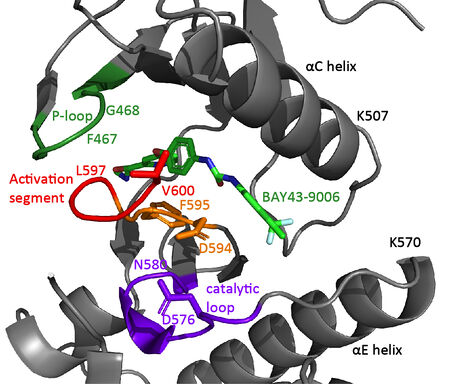
Known inhibitors
BAY43-9006
BAY43-9006(also known as Sorafenib) inhibits the catalytic activity of the kinase domain by stabilizing it in its inactive conformation. [15]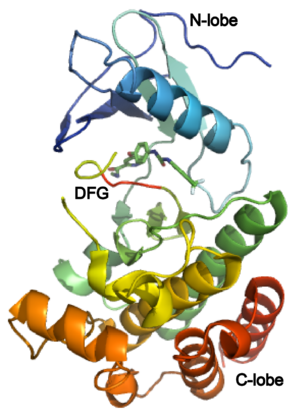
Vemurafenib
Vemurafenib unlike sorafenib inhibits the active conformation of B-Raf by blocking the ATP-binding site. It was the first drug designed using fragment-based lead discovery to be approved. [16]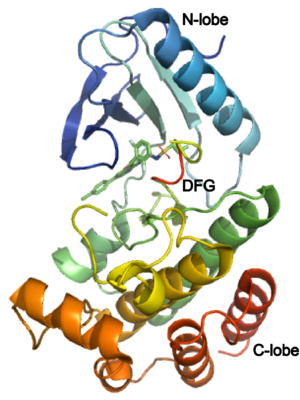
- ↑ Daum G, Eisenmann-Tappe I, Fries HW, Troppmair J, Rapp UR. The ins and outs of Raf kinases. Trends Biochem Sci. 1994 Nov;19(11):474-80. doi: 10.1016/0968-0004(94)90133-3. PMID:7855890 doi:http://dx.doi.org/10.1016/0968-0004(94)90133-3
- ↑ Robinson MJ, Cobb MH. Mitogen-activated protein kinase pathways. Curr Opin Cell Biol. 1997 Apr;9(2):180-6. PMID:9069255
- ↑ Nassar N, Horn G, Herrmann C, Scherer A, McCormick F, Wittinghofer A. The 2.2 A crystal structure of the Ras-binding domain of the serine/threonine kinase c-Raf1 in complex with Rap1A and a GTP analogue. Nature. 1995 Jun 15;375(6532):554-60. PMID:7791872 doi:http://dx.doi.org/10.1038/375554a0
- ↑ 9689060
- ↑ Hanks SK, Hunter T. Protein kinases 6. The eukaryotic protein kinase superfamily: kinase (catalytic) domain structure and classification. FASEB J. 1995 May;9(8):576-96. PMID:7768349
- ↑ Guo YJ, Pan WW, Liu SB, Shen ZF, Xu Y, Hu LL. ERK/MAPK signalling pathway and tumorigenesis. Exp Ther Med. 2020 Mar;19(3):1997-2007. doi: 10.3892/etm.2020.8454. Epub 2020 Jan, 15. PMID:32104259 doi:http://dx.doi.org/10.3892/etm.2020.8454
- ↑ Vijayan RS, He P, Modi V, Duong-Ly KC, Ma H, Peterson JR, Dunbrack RL Jr, Levy RM. Conformational analysis of the DFG-out kinase motif and biochemical profiling of structurally validated type II inhibitors. J Med Chem. 2015 Jan 8;58(1):466-79. doi: 10.1021/jm501603h. Epub 2014 Dec 12. PMID:25478866 doi:http://dx.doi.org/10.1021/jm501603h
- ↑ Zhang BH, Guan KL. Activation of B-Raf kinase requires phosphorylation of the conserved residues Thr598 and Ser601. EMBO J. 2000 Oct 16;19(20):5429-39. doi: 10.1093/emboj/19.20.5429. PMID:11032810 doi:http://dx.doi.org/10.1093/emboj/19.20.5429
- ↑ Wan PT, Garnett MJ, Roe SM, Lee S, Niculescu-Duvaz D, Good VM, Jones CM, Marshall CJ, Springer CJ, Barford D, Marais R. Mechanism of activation of the RAF-ERK signaling pathway by oncogenic mutations of B-RAF. Cell. 2004 Mar 19;116(6):855-67. PMID:15035987
- ↑ Wan PT, Garnett MJ, Roe SM, Lee S, Niculescu-Duvaz D, Good VM, Jones CM, Marshall CJ, Springer CJ, Barford D, Marais R. Mechanism of activation of the RAF-ERK signaling pathway by oncogenic mutations of B-RAF. Cell. 2004 Mar 19;116(6):855-67. PMID:15035987
- ↑ Wan PT, Garnett MJ, Roe SM, Lee S, Niculescu-Duvaz D, Good VM, Jones CM, Marshall CJ, Springer CJ, Barford D, Marais R. Mechanism of activation of the RAF-ERK signaling pathway by oncogenic mutations of B-RAF. Cell. 2004 Mar 19;116(6):855-67. PMID:15035987
- ↑ Manning G, Whyte DB, Martinez R, Hunter T, Sudarsanam S. The protein kinase complement of the human genome. Science. 2002 Dec 6;298(5600):1912-34. PMID:12471243 doi:10.1126/science.1075762
- ↑ Wan PT, Garnett MJ, Roe SM, Lee S, Niculescu-Duvaz D, Good VM, Jones CM, Marshall CJ, Springer CJ, Barford D, Marais R. Mechanism of activation of the RAF-ERK signaling pathway by oncogenic mutations of B-RAF. Cell. 2004 Mar 19;116(6):855-67. PMID:15035987
- ↑ Wan PT, Garnett MJ, Roe SM, Lee S, Niculescu-Duvaz D, Good VM, Jones CM, Marshall CJ, Springer CJ, Barford D, Marais R. Mechanism of activation of the RAF-ERK signaling pathway by oncogenic mutations of B-RAF. Cell. 2004 Mar 19;116(6):855-67. PMID:15035987
- ↑ Lowinger TB, Riedl B, Dumas J, Smith RA. Design and discovery of small molecules targeting raf-1 kinase. Curr Pharm Des. 2002;8(25):2269-78. doi: 10.2174/1381612023393125. PMID:12369855 doi:http://dx.doi.org/10.2174/1381612023393125
- ↑ Bollag G, Tsai J, Zhang J, Zhang C, Ibrahim P, Nolop K, Hirth P. Vemurafenib: the first drug approved for BRAF-mutant cancer. Nat Rev Drug Discov. 2012 Nov;11(11):873-86. doi: 10.1038/nrd3847. Epub 2012 Oct , 12. PMID:23060265 doi:http://dx.doi.org/10.1038/nrd3847
